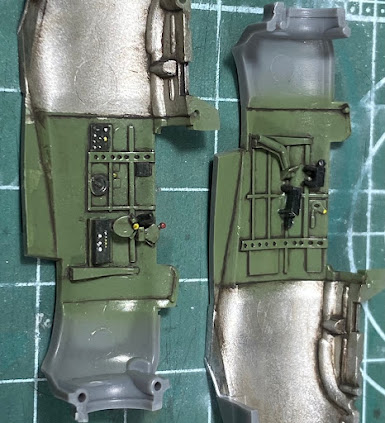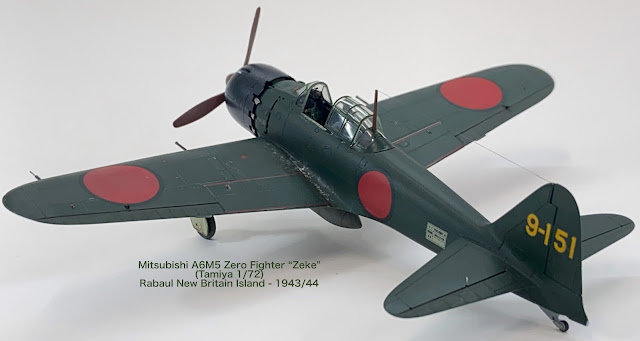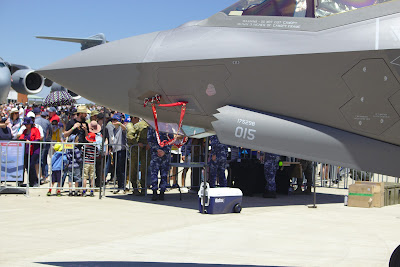F.M.A. IA-58A Pucará (Special Hobby 1/72)
Argentinian Air Force (A-511)
Brigada Aerea III / Grupo 3 de Ataque - Escuadrón Pucará Malvinas Pilot: mayor Carlos Tomba
Argentinian Air Force (A-511)
Brigada Aerea III / Grupo 3 de Ataque - Escuadrón Pucará Malvinas Pilot: mayor Carlos Tomba
Kit: Special Hobby #SH 72047 Scale: 1/72
Aftermarket: No aftermarket used, built out of the box with a few scratch built details.
The kit is a short run, overall fitting is bad. It comes with some resin and PE parts.
There are plenty of versions to chose from for the Pucará during the Falklands war, however I decided to model the A-511 after reading the account below from the book The Pucará Story, Mushroom White Series 9121, by Ricardo Caballero and Phil Cater. Mushroom Model Publications, 2013.
"Premier Teniente Juan Micheloud in A-533, and Mayor Carlos Tomba in A-511 engaged in a rocket attack on an observation post which had been directing naval gunfire from HMS Ardent against Condor/Darwin, but while seeking further targets, they were detected by HMS Brilliant’s radar controllers, and jumped by three Sea Harriers from 801 NAS on a nearby Combat Air Patrol - Lt Steve Thomas in XZ456/008, Lt Alisdair Craig in his first CAP in XZ495/003, and Lt Cdr “Sharkey" Ward, leading the trio in XZ451/006.
Micheloud escaped into a low valley, but Tomba’s aircraft was attacked simultaneously by the two Sea Harriers flown by Thomas and Craig, though their cannon fire fell short. A-511 was then hit by 30mm cannon fire from Ward’s Sea Harrier. This attack set the starboard engine ablaze, and severely damaged the outer wing. The two other Sea Harriers also missed on their next pass, but a second ground level attack by Lt Cdr Ward again found its mark, this time hitting the port engine, setting that on fire and shattering the rear canopy. A third cannon attack by the other pair still missed, and it was only on a final pass that the Pucará was finally downed by the guns of Lt Cdr Ward, his shells setting the fuselage ablaze and scattering debris from the doomed aircraft. Mayor Tomba, showed great determination to fly on, despite being raked with cannon fire, only ejecting at extremely low altitude at the last possible moment. He parachuted near the wreckage, which had pancaked into the ground and broken up, its munitions exploding, while Ward’s Sea Harrier briefly circled above. Tomba then made his way to an abandoned house, and was later picked up by a Bell 212 of Grupo 7, and returned to Goose Green/BAM Condor. There, nine days later, he became a POW when the airfield and settlement fell to 2 Para on 30th May 1982.
Tomba later volunteered his services as an interpreter for the wounded Argentinian casualties being treated at the field hospital at Ajax bay, thereby helping to save life and limb - much to the gratitude of Surgeon Commander Rick Jolly. It was from him that Tomba learned of the high regard which the Sea Harrier pilots had for him in tenaciously staying with his aircraft under such intense fire - Sharkley Ward passing on a message exclaiming he was thrilled that Tomba was “alive, well and useful…!”
The account about was crucial to determine the ordnance (LAU-3 rocket launcher) that I chose to equip the model.
Modifications to the kit:
- Separated the 1 piece canopy in order to display it opened .
- 4 x LAU-3 Rocket launcher (Hasegawa 1/72 scale Aircraft Weapons: 1 - US Bombs & Rocket Launchers, #X72-1).
- Scratch-built wing positioning lights.
- Scratch-built landing lights on the wings pylons.
- Camouflage colour scheme: I wasn’t able to find a photo of A-511, however, according to the book The Pucará Story , Mushroom White Series 9121, by Ricardo Caballero and Phil Cater . Mushroom Model Publications, 2013 - Chapter 6: Camouflages and Markings and Notes for Modellers, on the table at pages 104 & 105 - Table for Ultimate 1982 Colour Guide, the Federal Standard (FS) suggested for A-511 are the same suggested for aircraft A-532 (which there is photo evidence). So I based on the available photo for A-532 to determine the right colours. I used the kit instructions as reference for the camouflage pattern. The anti-aircraft recognition panels (yellow markings) were included. In the kit instruction it does not show the yellow panel under the wing, which is a mistake from the instructions since it was the current procedure for the panel painting and present on the photo for A-532.
Extra reference photos:
Below is the only known photo of the A-511, unfortunately made a few years after the crash.
Landing gear detail for the brake line, this is a post war aircraft so the landing gear is painted instead of anodised aluminium
Final photos:
Below are the finished model photos.
Cheers!























































































































